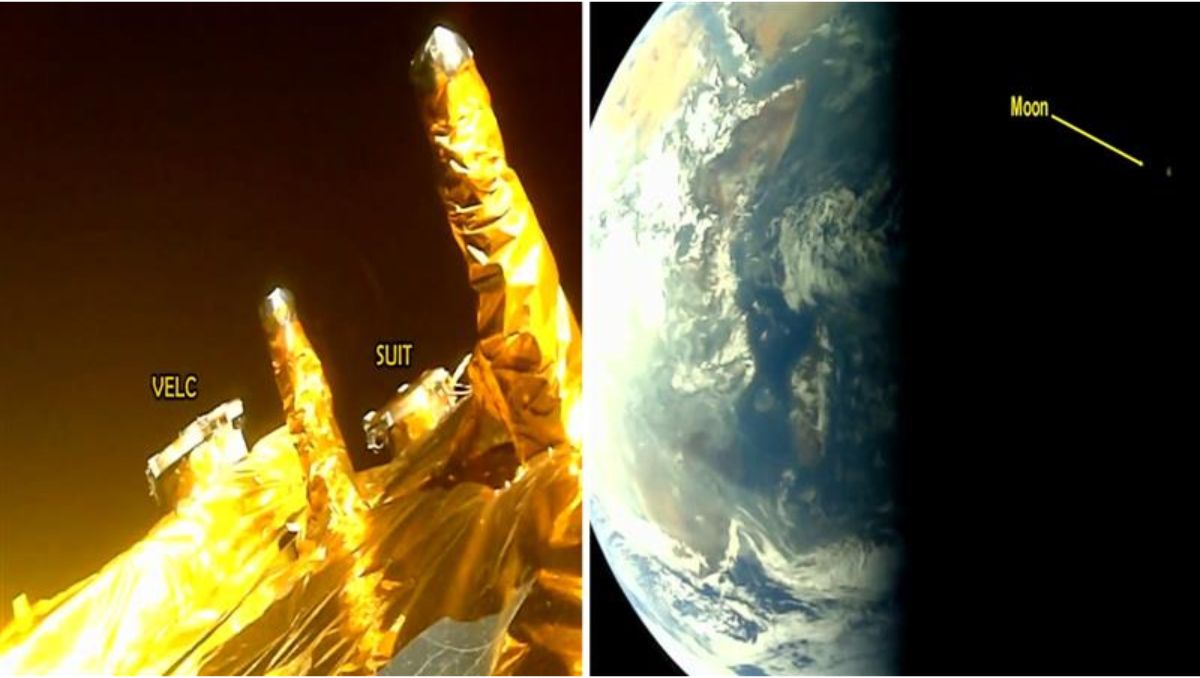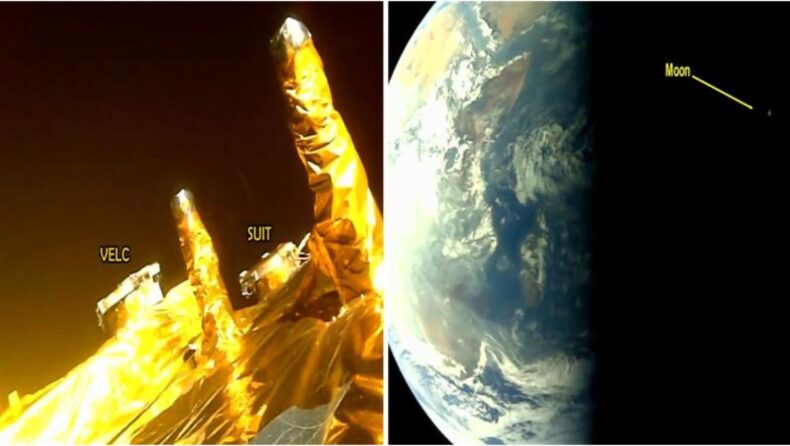Aditya-L1 is ISRO’S latest aim after it’s success in reaching the South Pole of the Moon through Chandrayaan. ISRO was able to do something, incredible and commendable and is all set out to do so once more. So much so, that it made the New York Times apologize for their mocking cartoon. ISRO’s achievement on the journey to the far South of the Moon was commended by many across the globe.
The scientists, soon after having attained a success of this kind embarked on their journey to the Sun. India’s ambitious Aditya-L1 solar mission is making headlines with its recent captivating images, showcasing both its own presence in space and stunning views of Earth and the Moon. The Indian Space Research Organisation (ISRO) has provided the world with a unique “selfie” taken by Aditya-L1, offering a glimpse into the spacecraft’s groundbreaking work.
Table of Contents
Aditya-L1’s Selfie and Earth-Moon Imagery
The mesmerizing images released by ISRO include a self-portrait of Aditya-L1 in its elliptical orbit around Earth. The spacecraft is on a crucial mission to study the Sun and the surrounding space environment. In addition to the “selfie,” Aditya-L1 has captured captivating visuals of Earth, where one hemisphere is beautifully illuminated by sunlight, alongside a tiny white speck representing the Moon.

Scientific Objectives of Aditya-L1
Aditya-L1 aims to unravel the mysteries of the Sun, focusing on its corona and the layers of its atmosphere. The mission boasts two main scientific instruments: the Visible Emission Line Coronagraph (VELC) and the Solar Ultraviolet Imaging Telescope (SUIT). VELC is set to explore the innermost layers of the solar corona, providing insights not accessible through previous missions. SUIT will delve into the various layers of the solar atmosphere using shorter UV wavelengths, a capability unavailable from Earth.
Aditya-L1’s Orbital Journey
Aditya-L1 is currently executing a series of maneuvers to elevate its orbit and velocity before embarking on its journey to the Sun. On September 5, the spacecraft successfully completed its second maneuver, reaching an orbit of 282 km x 40,225 km. The next crucial maneuver is scheduled for September 10 at 02:30 a.m.
Once Aditya-L1 is propelled toward the Sun, it will traverse a distance of approximately 1.5 million kilometers to reach the Sun-Earth L1 point. This unique position offers an unobstructed, round-the-clock view of the Sun. While Aditya-L1’s planned mission lifespan is five years, its potential longevity is extended due to the stable gravitational equilibrium at the L1 point, allowing it to function for up to 25 years.
Longevity and Data Contribution
Aditya-L 1’s extended mission life could emulate the success of the ESA/NASA mission known as the Solar and Heliospheric Observatory (SOHO), which was initially designed for a two-year mission but has now been continuously gathering solar data for over 27 years at the L1 point.
The significance of Aditya-L1’s mission lies in its VELC instrument’s ability to provide data that scientists eagerly await. This instrument will allow scientists to study the solar corona closer to the surface of the Sun than previously possible, filling the gap left by a lost coronagraph aboard SOHO. With a smaller occulting disk, Aditya-L1 is poised to capture valuable data from the very beginnings of the solar corona.
Conclusion
As Aditya-L1 continues its journey towards the Sun-Earth L1 point, it promises a bright future for solar science and a deeper understanding of our Sun’s enigmatic corona. With its extended mission life and advanced instruments, Aditya-L1 is poised to contribute significantly to our knowledge of the Sun, enhancing our ability to predict and understand solar activity and its impact on our planet. ISRO’s pioneering solar mission is undoubtedly one of India’s most remarkable contributions to space exploration.













